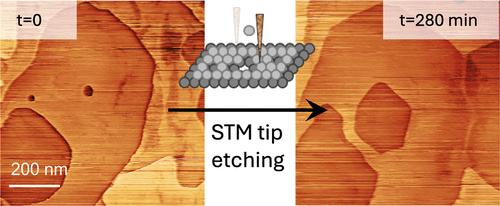STM显示的2H-TaS2的尖端诱导刻蚀和空位岛演化
IF 3.2
3区 化学
Q2 CHEMISTRY, PHYSICAL
引用次数: 0
摘要
最近利用扫描探针显微镜对二维材料进行的研究表明,在测量过程中,可以通过隧道场驱动或扫描探针驱动的方法对过渡金属二硫族化物表面进行蚀刻。尖端对表面结构和缺陷的操纵是利用扫描探针进行纳米光刻的第一步。实空间扫描隧道显微镜实验提供了一个表面缺陷清单,其中包括线性和点状缺陷的2H-TaS2化学气相输送生长。长时间的成像触发了空位岛的形成,这些空位岛随着时间的推移而增长和合并,导致整个层的连续移除。利用人工智能和传统的图像分析工具,观察了长时间内空位的生长动力学,并对其进行了量化。空缺岛的周长呈线性增长,孤岛的面积呈抛物线增长。在蚀刻机制的框架下讨论了单个岛屿的生长速率变化,包括尖端诱导化学,水吸附蚀刻和支持TaS2表面空位岛成核的天然缺陷。除去表层后,新暴露的层中迅速出现新的空位岛。重新沉积的小而可移动的表面岛屿参与了尖端诱导蚀刻机制。蚀刻动力学的定量分析是实现TaS2表面纳米结构自动化的第一步。这项工作为使用扫描隧道显微镜构建更复杂的二维材料结构铺平了道路。本文章由计算机程序翻译,如有差异,请以英文原文为准。

Tip-Induced Etching and Vacancy Island Evolution on 2H-TaS2 Revealed by STM
Recent research on 2D materials using scanning probe microscopy reveals that the surface of transition metal dichalcogenides can be etched during the measurement via either a tunneling-field-driven or a scanning probe-driven process. The tip-induced manipulation of the surface structure and defects is a first step toward nanolithography using scanning probes. Real-space scanning tunneling microscopy experiments provide a surface defect inventory, which includes linear and point defects for 2H-TaS2 grown by chemical vapor transport. Extended periods of imaging trigger the formation of vacancy islands that grow and coalesce over time, leading to the sequential removal of entire layers. The growth kinetics of vacancies were observed over extended periods and quantified using AI and conventional image analysis tools. The vacancy islands have a linear growth rate of their perimeter and corresponding parabolic growth rates in the area for isolated islands. The growth rate variance of individual islands is discussed in the framework of etching mechanisms including tip-induced chemistry, etching by water adsorbates, and native defects that support vacancy island nucleation in the TaS2 surface. New vacancy islands emerge rapidly in newly exposed layers after the top layer is removed. Small and mobile surface islands that are redeposited are revealed to participate in the tip-induced etching mechanism. The quantitative analysis of etching kinetics is a first step toward automated nanostructuring of TaS2 surfaces. This work paves the way to use scanning tunneling microscopy to build more complex 2D material structures.
求助全文
通过发布文献求助,成功后即可免费获取论文全文。
去求助
来源期刊

The Journal of Physical Chemistry C
化学-材料科学:综合
CiteScore
6.50
自引率
8.10%
发文量
2047
审稿时长
1.8 months
期刊介绍:
The Journal of Physical Chemistry A/B/C is devoted to reporting new and original experimental and theoretical basic research of interest to physical chemists, biophysical chemists, and chemical physicists.
 求助内容:
求助内容: 应助结果提醒方式:
应助结果提醒方式:


